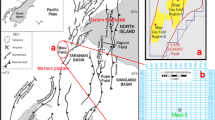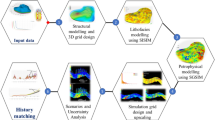Abstract
The effectiveness of secondary recovery methods in reservoir development studies depends on the knowledge about how fluid-carrying regions (i.e. good-quality rock types) are connected between injection and production wells. To estimate reservoir performance uncertainty, comprehensive simulations on many reservoir model realisations are necessary, which is very CPU consuming and time demanding. Alternatively, we can use much simpler and physically based methods such as percolation approach. Classic percolation assumes connectivity between opposite 2-D faces of a 3-D system; whereas, hydrocarbon production is achieved through active wells that are one-dimensional lines (e.g. vertical, horizontal or deviated wells). The main contribution of this study is to analyse the percolation properties of 3-D continuum percolation models with more realistic well representations during secondary recovery. In particular, the connection of randomly distributed sands (i.e. good-quality rock types) between two lines (representing two wells) located at two corners of the system are modelled by Monte Carlo simulations. Subsequently, the connectivity and conductivity of such a line-to-line well representation is compared with that of face-to-face well representations in the previously published results. The critical percolation properties of those systems as well as the universality concept are also investigated. As there are many rooms for connections in 3-D models, we found that the principal percolation properties will not be altered significantly when the problem with a face-to-face connection is transformed to a line-to-line connection model.
Similar content being viewed by others
References
Sadeghnejad, S., Masihi, M.: Water flooding performance evaluation using percolation theory. J. Pet. Sci. Tech. 1, 19–23 (2011)
Berkowitz, B., Balberg, I.: Percolation theory and its application to groundwater hydrology. Water. Resour. Res. 29, 775–794 (1993)
Sahimi, M.: Applications of Percolation Theory. Taylor & Francis (1994)
Bour, O., Davy, P.: On the connectivity of three-dimensional fault networks. Water. Resour. Res. 34, 2611–2622 (1998)
Sadeghnejad, S., Masihi, M., Shojaei, A., Pishvaie, M., King, P. R.: Field scale characterization of geological formations using percolation theory. Transp. Porous Med. 92, 357–372 (2012)
Nurafza, P. R., King, P. R., Masihi, M.: Facies connectivity modelling: analysis and field study SPE Europec/EAGE Annual Conference and Exhibition. Society of Petroleum Engineers (2006)
Stauffer, D., Aharony, A.: Introduction to Percolation Theory. CRC Press (1994)
Renard, P., Allard, D.: Connectivity metrics for subsurface flow and transport. Adv. Water. Resour. 51, 168–196 (2013)
Berkowitz, B.: Characterizing flow and transport in fractured geological media: a review. Adv. Water. Resour. 25, 861–884 (2002)
King, P. R.: The connectivity and conductivity of overlapping sand bodies. In: Buller, A. T. et al. (eds.) North Sea Oil and Gas Reservoirs—II, pp 353–362. Springer, Netherlands (1990)
Ozkaya, S. I., Mattner, J.: Fracture connectivity from fracture intersections in borehole image logs. Comput. Geosci. 29, 143–153 (2003)
Mourzenko, V. V., Thovert, J. F., Adler, P. M.: Percolation of three-dimensional fracture networks with power-law size distribution. Phys. Rev. E. 72, 036103 (2005)
Belayneh, M., Masihi, M., Matthäi, S. K., King, P. R.: Prediction of vein connectivity using the percolation approach: model test with field data. J. Geophys. Eng. 3, 219 (2006)
Tóth, T. M., Vass, I.: Relationship between the geometric parameters of rock fractures, the size of percolation clusters and REV. Math. Geosci. 43, 75–97 (2011)
Sadeghnejad, S., Masihi, M., King, P. R.: Dependency of percolation critical exponents on the exponent of power law size distribution. Phys. A 392, 6189–6197 (2013)
Dokholyan, N., Lee, Y., Buldyrev, S., Havlin, S., King, P., Stanley, H. E.: Scaling of the distribution of shortest paths in percolation. J. Stat. Phys. 93, 603–613 (1998)
Dokholyan, N. V., Buldyrev, S. V., Havlin, S., King, P. R., Lee, Y., Stanley, H. E.: Distribution of shortest paths in percolation. Phys. A 266, 55–61 (1999)
Andrade, J. S., Buldyrev, S. V., Dokholyan, N. V., Havlin, S., King, P. R., Lee, Y., Paul, G., Eugene Stanley, H.: Flow between two sites on a percolation cluster. Phys. Rev. E. 62, 8270–8281 (2000)
Andrade, J. Jr, Araujo, A., Buldyrev, S., Havlin, S., Stanley, H.: Dynamics of viscous penetration in percolation porous media. Phys. Rev. E. 63, 051403 (2001)
Lee, Y., Andrade, J. S., Buldyrev, S. V., Dokholyan, N. V., Havlin, S., King, P. R., Paul, G., Stanley, H. E.: Traveling time and traveling length in critical percolation clusters. Phys. Rev. E. 60, 3425–3428 (1999)
López, E., Buldyrev, S. V., Braunstein, L. A., Havlin, S., Stanley, H. E.: Possible connection between the optimal path and flow in percolation clusters. Phys. Rev. E. 72, 056131 (2005)
Paul, G., Havlin, S., Stanley, H. E.: Fractal behavior of the shortest path between two lines in percolation systems. Phys. Rev. E. 65, 066105 (2002)
da Silva, L. R., Paul, G., Havlin, S., Baker, D. R., Stanley, H. E.: Scaling of cluster mass between two lines in 3d percolation. Phys. A 318, 307–318 (2003)
Araújo, A. D., Moreira, A. A., Makse, H. A., Stanley, H. E., Andrade, J. S.: Traveling length and minimal traveling time for flow through percolation networks with long-range spatial correlations. Phys. Rev. E. 66, 046304 (2002)
Soares, R. F., Corso, G., Lucena, L. S., Freitas, J. E., da Silva, L. R., Paul, G., Stanley, H. E.: Distribution of shortest paths at percolation threshold: application to oil recovery with multiple wells. Phys. A 343, 739–747 (2004)
King, P. r., Buldyrev, S. v., Dokholyan, N. v., Havlin, S., Lee, Y., Paul, G., Stanley, H. e.: Applications of statistical physics to the oil industry: predicting oil recovery using percolation theory. Phys. A 274, 60–66 (1999)
King, P. R., Buldyrev, S. V., Dokholyan, N. V., Havlin, S., Lee, Y., Paul, G., Stanley, H. E., Vandesteeg, N.: Predicting oil recovery using percolation theory. Petrol. Geosci. 7, S105–S107 (2001)
King, P. R., Buldyrev, S. V., Dokholyan, N. V., Havlin, S., Lopez, E., Paul, G., Stanley, H. E.: Uncertainty in oil production predicted by percolation theory. Phys. A 306, 376–380 (2002)
King, P. R., Buldyrev, S. V., Dokholyan, N. V., Havlin, S., Lopez, E., Paul, G., Stanley, H. E.: Using percolation theory to predict oil field performance. Phys. A 314, 103–108 (2002)
Tavagh-Mohammadi, B., Masihi, M., Ganjeh-Ghazvini, M.: Point-to-point connectivity prediction in porous media using percolation theory. Phys. A 460, 304–313 (2016)
Sadeghnejad, S., Masihi, M.: Point to point continuum percolation in two dimensions. J. Stat. Mech. 2016, 103210 (2016)
Sadeghnejad, S., Masihi, M., King, P.: Study the connectivity of good sands between two wells represented by two points using percolation theory 78th EAGE Conference and Exhibition, Vienna (2016)
Sadeghnejad, S., Masihi, M., King, P., Gago, P.: Study the effect of connectivity between two wells on secondary recovery efficiency using percolation approach ECMOR XV—15th European Conference on the Mathematics of Oil Recovery (2016)
Koltermann, C. E., Gorelick, S. M.: Heterogeneity in sedimentary deposits: a review of structure-imitating, process-imitating, and descriptive approaches. Water. Resour. Res. 32, 2617–2658 (1996)
Ronayne, M. J., Gorelick, S. M.: Effective permeability of porous media containing branching channel networks. Phys. Rev. E. 73, 026305 (2006)
Watson, A., Gavalas, G., Seinfeld, J.: Identifiability of estimates of two-phase reservoir properties in history matching. Soc. Pet. Eng. J. 24, 697–706 (1984)
Grader, A. S., Horne, R. N.: Interference testing: detecting a circular impermeable or compressible subregion. SPE Form. Eval. 3, 420–428 (1988)
Kahrobae, S., Habibabadi, M. M., Joosten, G. J., Van den Hof, P. M., Jansen, J. -D.: Identifiability of location and magnitude of flow barriers in slightly compressible flow. SPE J. 21(3), 899–908 (2016)
Levitan, M., Crawford, G.: General heterogeneous radial and linear models for well-test analysis. SPE J. 7, 131–138 (2002)
Prakash, S., Havlin, S., Schwartz, M., Stanley, H. E.: Structural and dynamical properties of long-range correlated percolation. Phys. Rev. A. 46, R1724–R1727 (1992)
Sahimi, M., Mukhopadhyay, S.: Scaling properties of a percolation model with long-range correlations. Phys. Rev. E. 54, 3870–3880 (1996)
Masihi, M., King, P. R.: A correlated fracture network: modeling and percolation properties. Water. Resour. Res. 43 (2007)
Baker, D. R., Paul, G., Sreenivasan, S., Stanley, H. E.: Continuum percolation threshold for interpenetrating squares and cubes. Phys. Rev. E. 66, 046136 (2002)
Garboczi, E. J., Thorpe, M. F., DeVries, M. S., Day, A. R.: Universal conductivity curve for a plane containing random holes. Phys. Rev. A. 43, 6473–6482 (1991)
Alon, U., Drory, A., Balberg, I.: Systematic derivation of percolation thresholds in continuum systems. Phys. Rev. A. 42, 4634 (1990)
Dubson, M. A., Garland, J. C.: Measurement of the conductivity exponent in two-dimensional percolating networks: square lattice versus random-void continuum. Phys. Rev. B. 32, 7621–7623 (1985)
Sadeghnejad, S., Masihi, M., Pishvaie, M., Shojaei, A., King, P.: Utilization of percolation approach to evaluate reservoir connectivity and effective permeability: a case study on North Pars gas field. Scientica. Iranica. 18, 1391–1396 (2011)
Quintanilla, J., Torquato, S., Ziff, R.: Efficient measurement of the percolation threshold for fully penetrable discs. J. Phys. A. 33, L399 (2000)
Geiger, A., Stanley, H. E.: Tests of universality of percolation exponents for a three-dimensional continuum system of interacting waterlike particles. Phys. Rev. Let. 49, 1895 (1982)
Lorenz, C. D., Ziff, R. M.: Precise determination of the critical percolation threshold for the three-dimensional “Swiss cheese” model using a growth algorithm. T. J. Chem. Phys. 114, 3659–3661 (2001)
Sadeghnejad, S., Masihi, M., Pishvaie, M., King, P. R.: Rock type connectivity estimation using percolation theory. Math. Geosci. 45, 321–340 (2013)
Celzard, A., Marêché, J. F.: Non-universal conductivity critical exponents in anisotropic percolating media: a new interpretation. Phys. A 317, 305–312 (2003)
Vogel, E. E., Lebrecht, W., Valdés, J. F.: Bond percolation for homogeneous two-dimensional lattices. Phys. A 389, 1512–1520 (2010)
Grassberger, P.: Pair connectedness and shortest-path scaling in critical percolation. J. Phys. A 32, 6233 (1999)
Duquerroix, J., Lemouzy, P., Noetinger, B., Romeu, R.: Influence of the permeability anisotropy ratio on large-scale properties of heterogeneous reservoirs SPE Annual Technical Conference and Exhibition. Society of Petroleum Engineers (1993)
Bennett, S., McRobb, S., Farmer, R.: Object-Oriented Systems Analysis and Design Using UML. McGraw Hill Higher Education (2005)
Romeu, R., Noetinger, B.: Calculation of internodal transmissivities in finite difference models of flow in heterogeneous porous media. Water. Resour. Res. 31, 943–959 (1995)
Gautier, Y., Noetinger, B.: Preferential flow-paths detection for heterogeneous reservoirs using a new renormalization technique. Transp Porous Med. 26, 1–23 (1997)
Green, C. P., Paterson, L.: Analytical three-dimensional renormalization for calculating effective permeabilities. Transp Porous Med. 68, 237–248 (2007)
Karim, M. R., Krabbenhoft, K.: New renormalization schemes for conductivity upscaling in heterogeneous media. Transp Porous Med. 85, 677–690 (2010)
Noetinger, B.: About the determination of quasi steady state storativity and connectivity matrix of wells in 3D heterogeneous formations. Math. Geosci., 1–22 (2015)
Nøetinger, B.: An explicit formula for computing the sensitivity of the effective conductivity of heterogeneous composite materials to local inclusion transport properties and geometry. Multiscale Model. Simul. 11, 907–924 (2013)
King, P. R.: The use of renormalization for calculating effective permeability. Transp Porous Med. 4, 37–58 (1989)
Reynolds, P. J., Stanley, H. E., Klein, W.: Large-cell Monte Carlo renormalization group for percolation. Phys. Rev. B. 21, 1223–1245 (1980)
Levinshtein, M., Shklovskii, B., Shur, M., Efros, A.: The relation between the critical exponents of percolation theory. Soviet Journal of Experimental and Theoretical Physics 42, 197 (1976)
Adler, P. M., Thovert, J. -F.: Fractures and Fracture Networks, vol. 15 Springer Science & Business Media (1999)
Berkowitz, B.: Analysis of fracture network connectivity using percolation theory. Math Geol. 27, 467–483 (1995)
Harter, T.: Finite-size scaling analysis of percolation in three-dimensional correlated binary Markov chain random fields. Phys. Rev. E. 72, 026120 (2005)
Author information
Authors and Affiliations
Corresponding author
Rights and permissions
About this article
Cite this article
Sadeghnejad, S., Masihi, M. Analysis of a more realistic well representation during secondary recovery in 3-D continuum models. Comput Geosci 21, 1035–1048 (2017). https://doi.org/10.1007/s10596-017-9640-5
Received:
Accepted:
Published:
Issue Date:
DOI: https://doi.org/10.1007/s10596-017-9640-5




